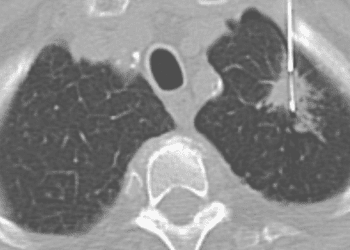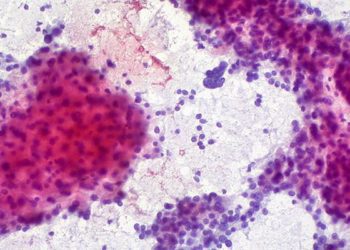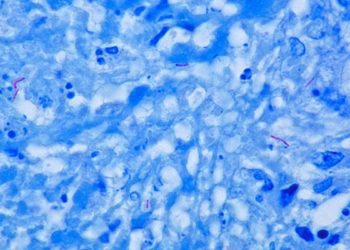Bevacizumab may aid tuberculosis therapy [PreClinical]
1. Tuberculosis (TB) granulomas exhibited similar properties to solid cancerous tumors, characterized as dense tissue masses with abnormal blood vessel distribution, which is thought to result in reduced penetration of TB drugs into the granuloma.
2. In a rabbit model of TB granulomas, treatment with the angiogenesis inhibitor bevacizumab, shown to normalize vascular in other pathological settings, led to improved delivery of a small molecule tracer dye throughout the granulomas.
Evidence Rating Level: 3 (Average)
Study Rundown: During TB infection, granulomas form when immune cells surround and block off the bacteria. Because granuloma tissue is dense, antibiotics may not evenly and efficiently reach the sequestered bacteria. This study showed that the distribution and morphology of blood vessels in TB granulomas were similar to those found in solid cancerous tumors. Blood vessels were leaky on the granuloma periphery and absent in the center, corresponding to poor fluorescent dye delivery to the middle of the granuloma. Further, granulomas expressed vascular endothelial growth factor (VEGF), a protein that promotes angiogenesis (blood vessel growth). The drug bevacizumab inhibits VEGF signaling and is currently used to improve solid tumor chemotherapy treatments by stabilizing abnormal tumor vasculature. In a rabbit model of TB granulomas, treatment with bevacizumab resulted in normalized vasculature structure and increased delivery of fluorescent dye throughout the granulomas. These improvements were seen 3 days following bevacizumab treatment but were lost by 8 days post-treatment, indicating a limited time frame of efficacy.
This study demonstrated a potential alternative indication for bevacizumab. Because the drug is currently on the market, its testing process for treating TB granulomas would be relatively brief. One limitation of the study was the use of a small fluorescent molecule as a surrogate for antibacterial compounds. While a recent study (linked below) showed that anti-VEGF treatment enhanced TB therapy in the zebrafish, delivery or efficacy of antibiotics in TB granulomas in conjunction with bevacizumab was not evaluated in this study. Overall, this study’s application of solid tumor biology to characterize TB granulomas could improve treatment for TB infection.
Click to read the study in PNAS
Relevant Reading: Interception of host angiogenic signalling limits mycobacterial growth
In-Depth [animal study]: To characterize TB granuloma morphology, histology was performed on human patient and rabbit resection tissues. Compared to healthy tissue samples, granuloma tissue samples showed higher VEGF expression, collapsed vasculature, and decreased presence of pericytes (cells that support vascular health). Blood vessels were present on the outside of granulomas but absent in the center. Specifically in rabbit granuloma tissue, microvessel density decreased from over 800 to 0 microvessels/mm2 when moving inwards from the granuloma edge by 1000µm. The delivery of the fluorescent dye Hoechst 33342 corresponded to the abnormal vasculature distribution, with fluorescence significantly decreasing to zero at 1000µm inwards from the granuloma edge.
Rabbits infected with TB were treated with 5 mg/kg of intravenous bevacizumab once per week. Three days post-treatment, granuloma blood vessel structure improved compared to untreated controls. Granuloma blood vessels increased in area coverage of the granuloma (p<0.01), number (not significant), pericyte coverage (p<0.05), and lumen area (p<0.05). Treatment reduced granuloma hypoxia (p=0.03) and necrosis (not significant). Delivery of Hoechst 33342 to the granuloma increased (p=0.04). By 8 days post-treatment, the majority of the improvements were lost. Compared to Day 3, the number of vessels decreased (p<0.01) and hypoxia increased (p=0.002). Delivery of Hoechst 33342 at Day 8 was not significantly different from control levels.
More from this author: Teixobactin appears to avoid bacteria resistance, Novel system rapidly detects low levels of bacteria in blood, Cell-loaded scaffold implant may improve cell therapy, Vaccines for predicted influenza strains may provide wide protection, Key gut bacteria may prevent Clostridium difficile infection
Image: PD
©2015 2 Minute Medicine, Inc. All rights reserved. No works may be reproduced without expressed written consent from 2 Minute Medicine, Inc. No article should be construed as medical advice and is not intended as such by the authors, editors, staff or by 2 Minute Medicine, Inc.







